Nemo Dragonfly OSMO 2-Person Tent review: light, strong and ready for the trail
The ultra-light, two-person Nemo Dragonfly OSMO is a great choice for all your backpacking needs
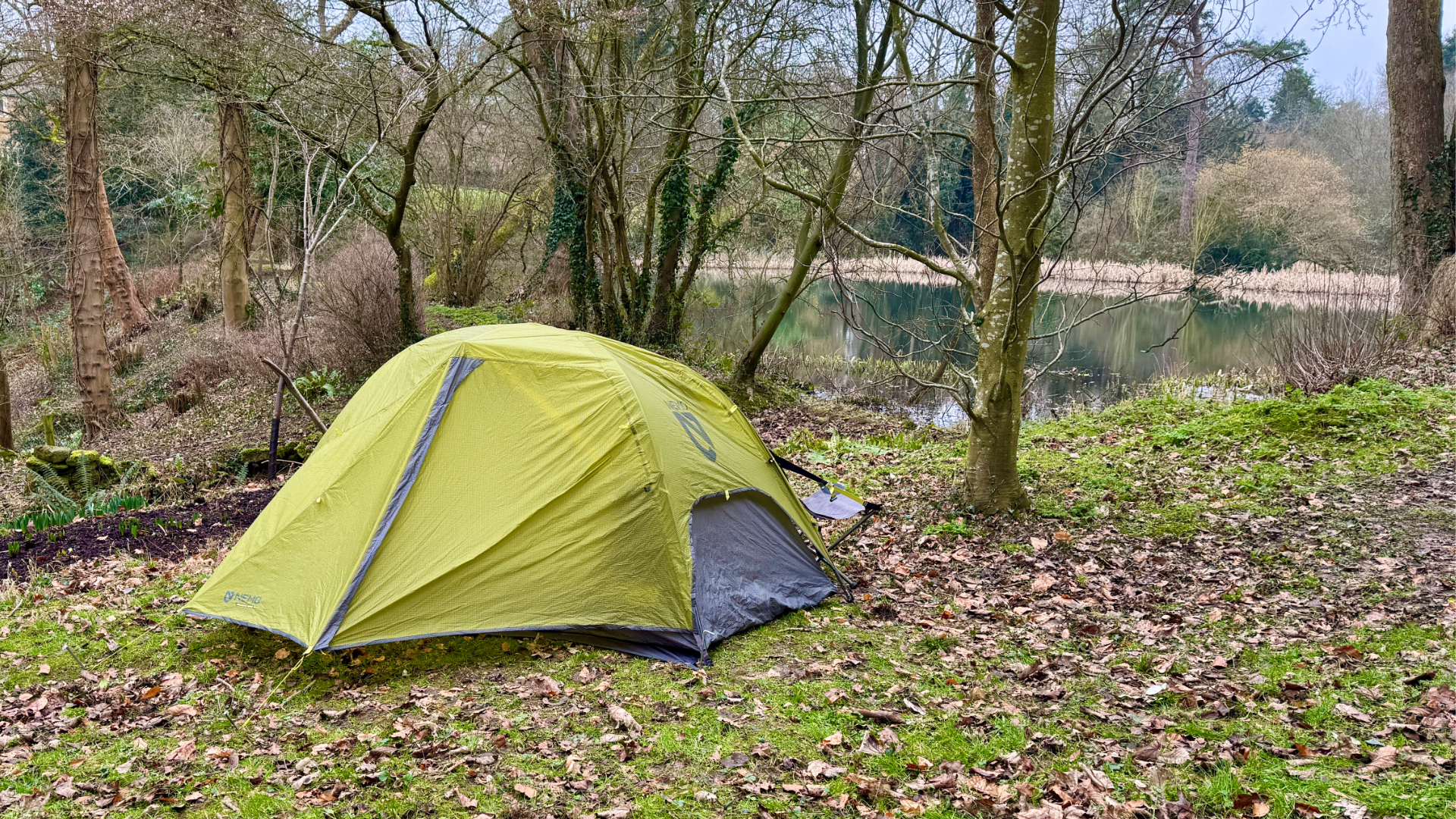
The Nemo Dragonfly OSMO two-person tent impresses with its balance of low weight and liveable space, especially if used solo. Easy setup and thoughtful features like double vestibules and integrated light pockets make it a pleasure to use. While the price is a bit high, the durable construction, specialised OSMO fabric and excellent three-season performance make it a worthwhile investment for serious backpackers and bike campers.
-
+
Unique OSMO fabric
-
+
Superior construction
-
+
Thoughtful interior
-
+
Ultra lightweight
-
-
Premium price tag
-
-
Tight stuff sack
-
-
Poor zip toggles
Why you can trust T3

Welcome to our review of the Nemo Dragonfly OSMO, a premium three-season model sporting a smorgasbord of tantalising design features, including a new proprietary tent material that just keeps on giving.
While not cheap to buy, the Dragonfly OSMO nevertheless provides a dry and cosy environment, and construction throughout is of the highest order. It’s also extremely easy to pitch.
As expected, this two-person model is a tight fit for two, but because it comes with two vestibules, you won’t have to climb over each other to get in and out. Does the Dragonfly OSMO warrant a peak position in our guide to the best backpacking tents? Let’s suck it and see.
Nemo Dragonfly OSMO 2-person tent review
Price and availability
The Nemo Dragonfly OSMO is available in three sizes – one, two and three-person. This two-person variant retails in the UK at £480 and is available direct from Nemo. Alternatively try Trekkit (£431.99), AlpinStore (£411.93), Ellis Brigham (£480) and The Climbers Shop (£432).
If you live in the USA, head straight for the Nemo store where it retails for $479.95 or try Amazon and Alpine Shop where it’s selling for the same price.
Specifications
- Seasons: 3-season
- Style: geodesic dome
- Sleeps: 2 (but best for one)
- Pack size: 50 x 14 x 9 cm / 19.5 x 5.5 x 3.5 inches
- Pack weight: 1.41 kg (3 lb 2 oz)
- Floor area: 2.7 m² (29 sq feet)
- Vestibule area: 0.9 m² (10.0 sq ft
- Peak height: 105 cm (41 in)
- Canopy Fabric: 10D Nylon Ripstop / No-see-‘em mesh
- Rainfly and floor fabric: OSMO Ripstop
- Rainfly Hydrostatic Head: 1,500 mm
- Floor Hydrostatic Head: 2,000 mm
Pitching process
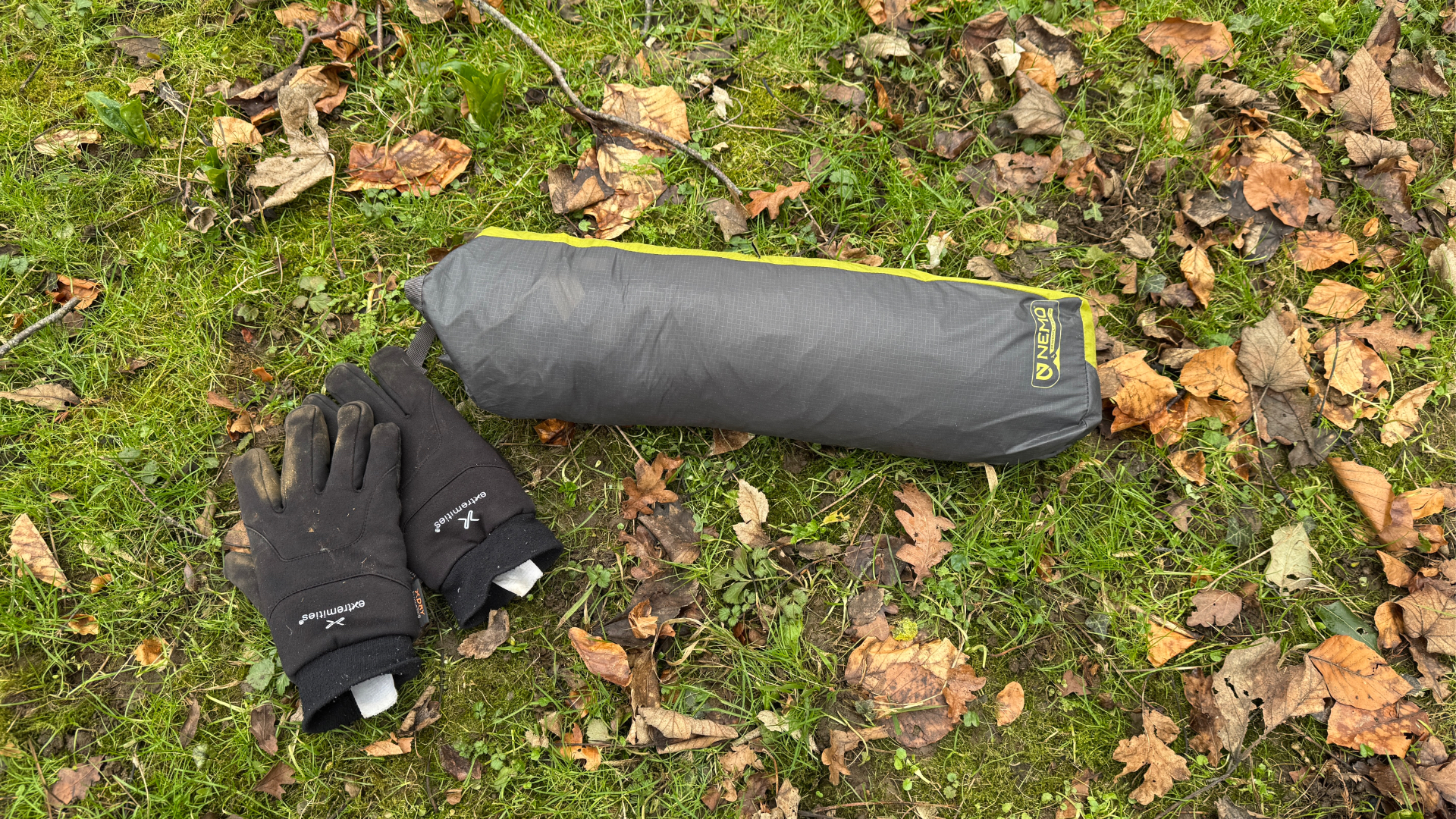
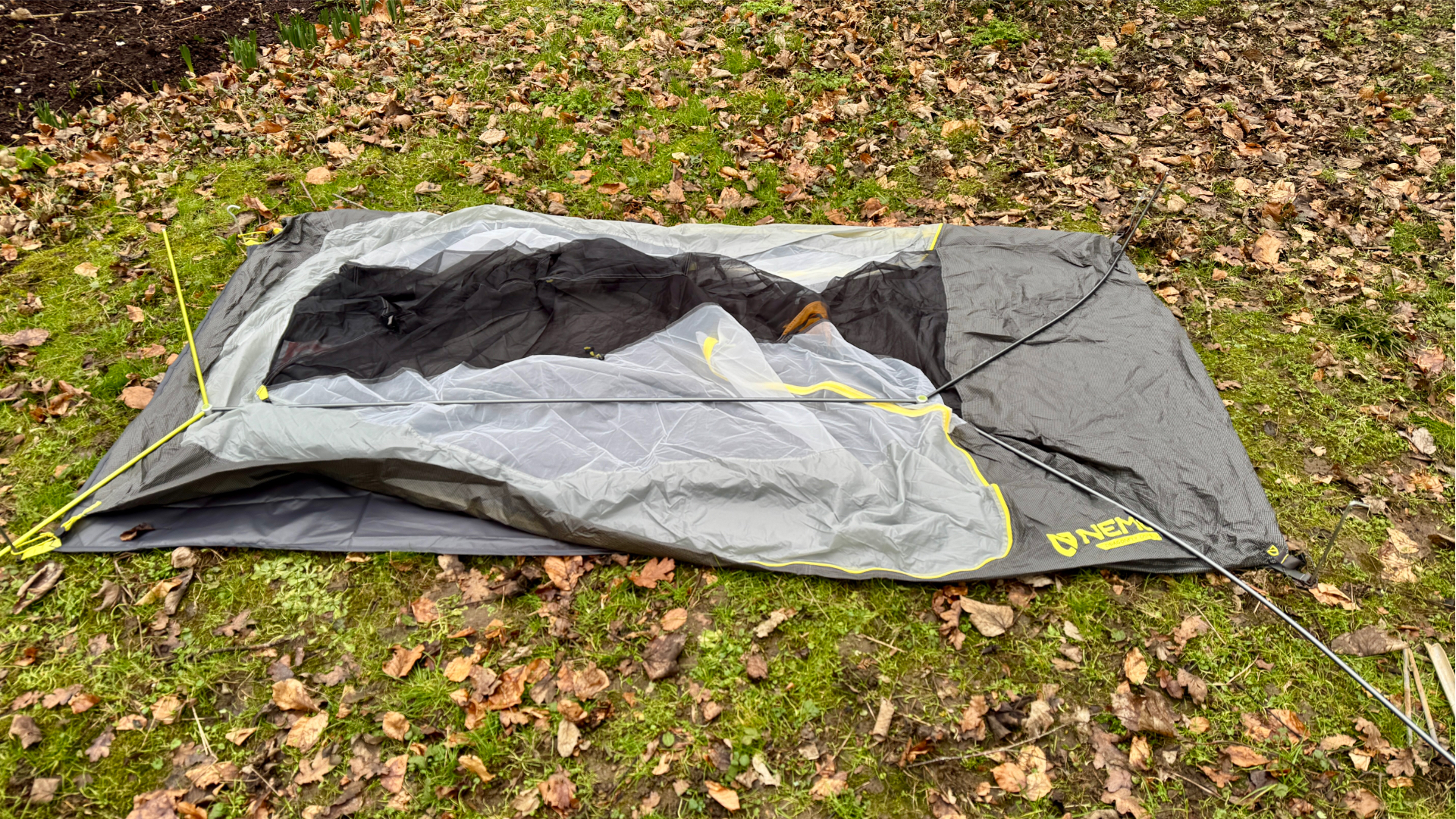
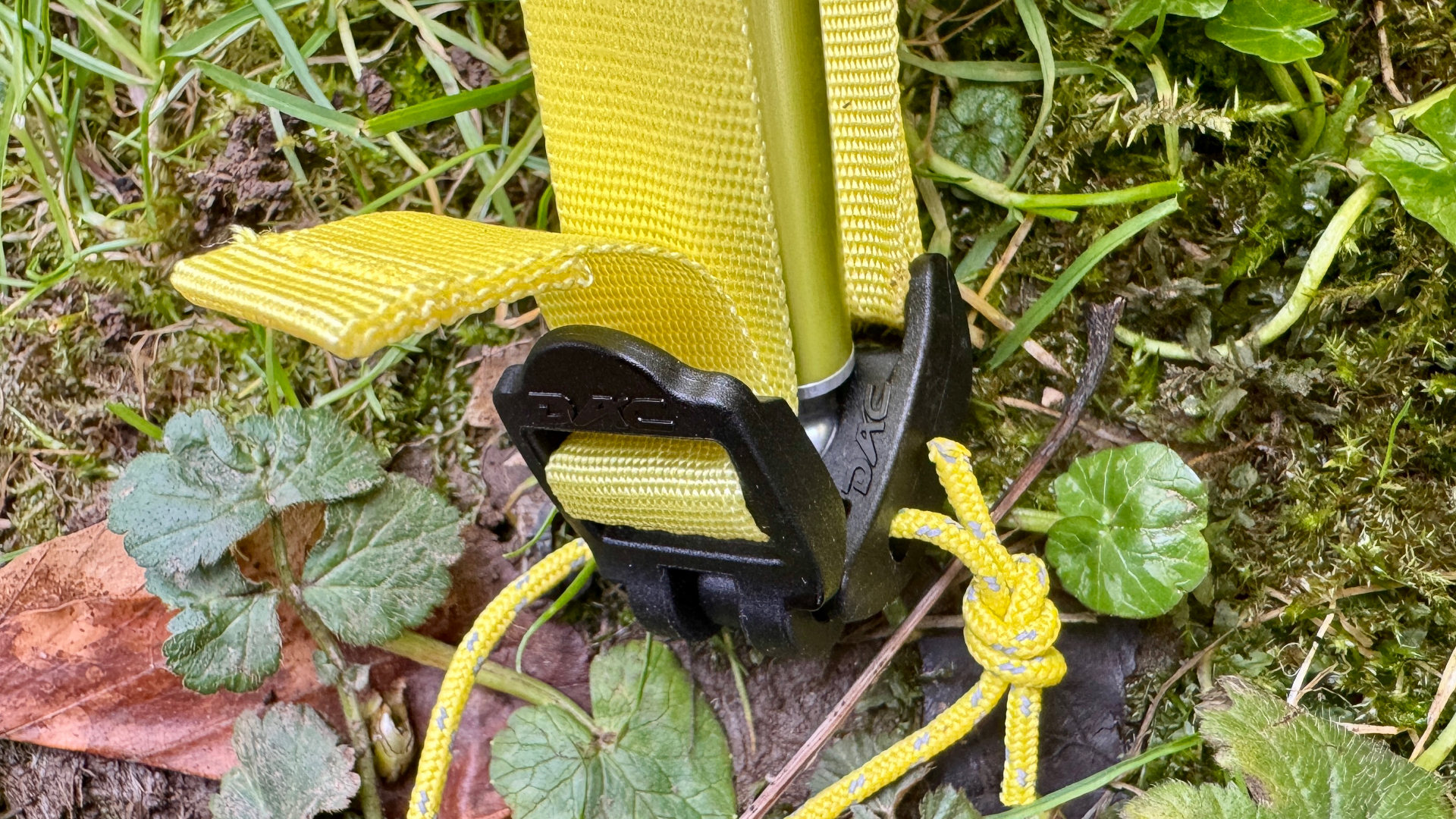
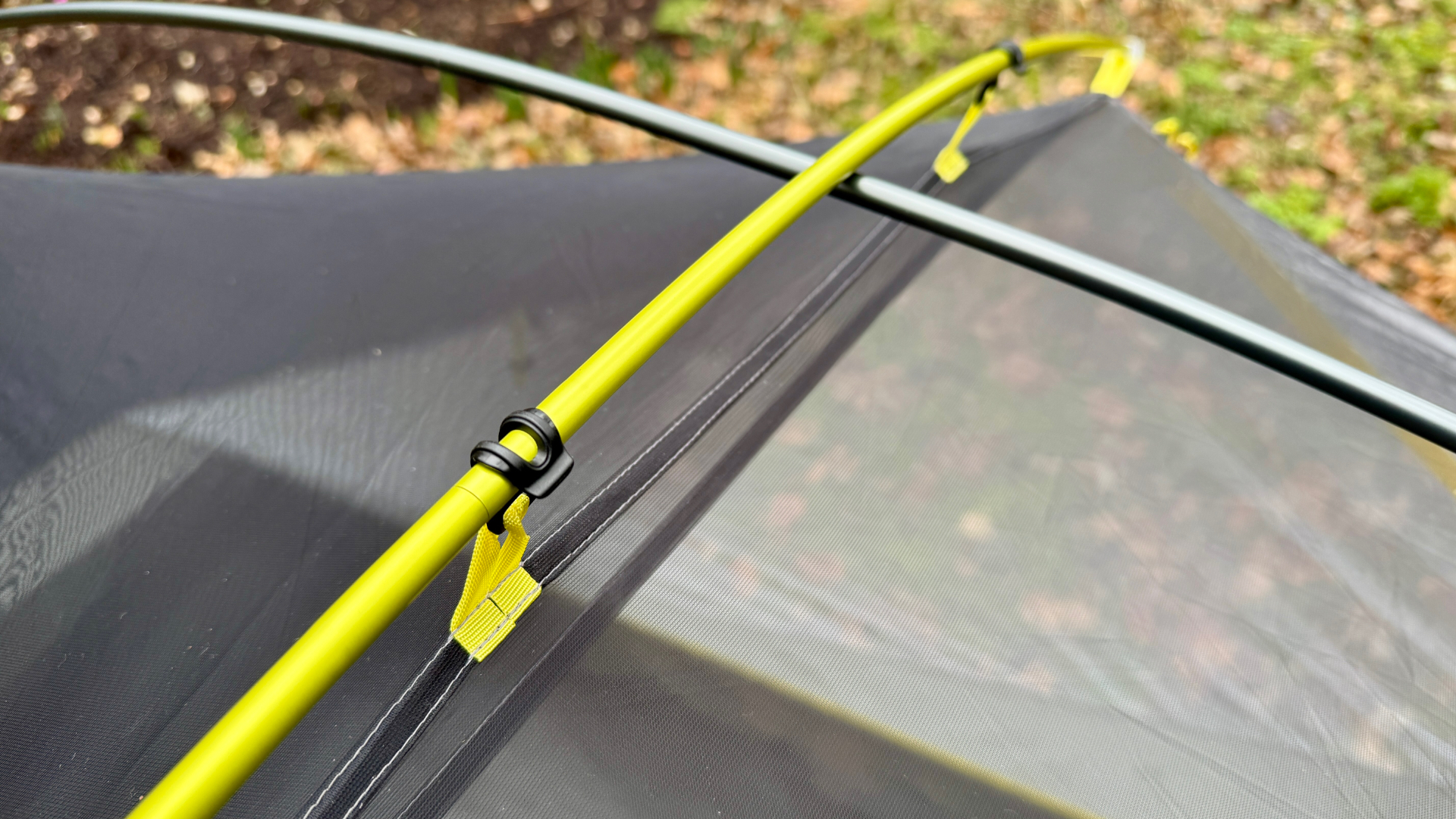
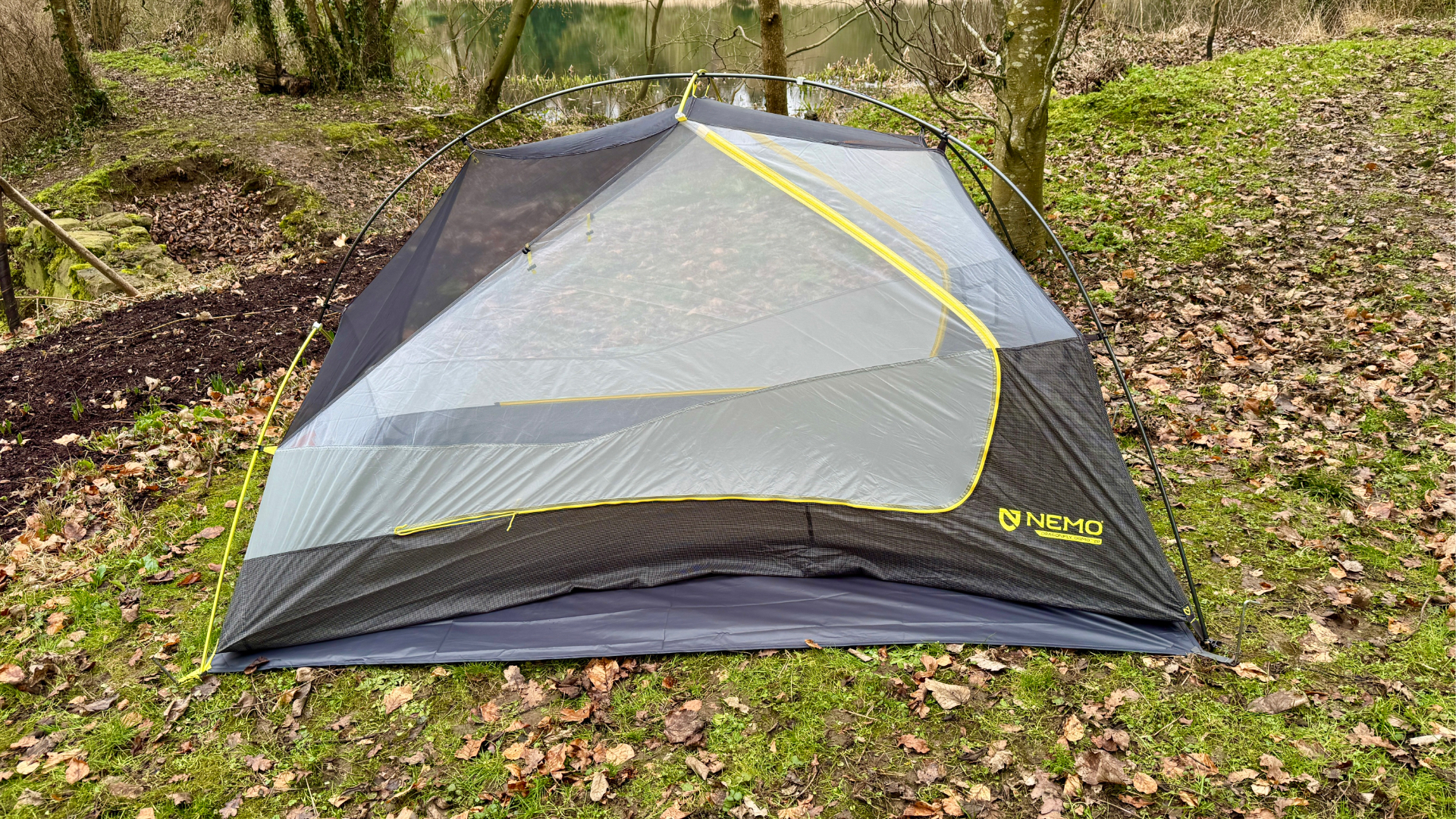
This tent is pitched inner sleeve first which can be an issue if setting up in the rain. Nevertheless, it pitched so quickly that I don’t think it would be too much of an issue. And besides, if you’re a savvy wilderness camper, chances are you’ll be keeping an eye on the weather and quickly find a suitable pitching spot before rain arrives.
Before we begin, I highly recommend the optional Nemo Dragonfly-specific outer groundsheet to protect the tent’s thin but robust floor from being damaged and help keep it dry and clean for tidier packing.
Start by laying the inner section over the groundsheet footprint and note the colour of the corner straps on each side. Now peg in all four corners using the top-quality pegs provided, grab the one-piece geodesic-style pole structure and unfurl the whole lot (since all poles are elasticated together, it’s super easy to do).
Next, insert the little aluminium ball sockets on each pole into their respective plastic ‘Jacob’s Foot’ clip holders at the base of each corner and start attaching all the U-hooks on the inner tent to the nearest section of the pole. Now reach for the separate short green pole, brace it across the top rear section of the main pole and clip it in. This pole creates a wide, taut ceiling space inside.
One brilliant facet here is that all the pole ends are a doddle to clip in, unlike some tents where you feel the pole might snap when bending. In fact, some sections of the main pole structure are pre-bent for easier pitching and better structural integrity.
Now, it’s time to pitch the outer section. First note the colours of the top flysheet’s floor connector straps and throw the fly over the inner tent by doing your best lasso interpretation, then clip in the four corners. Finish with guy lines for extra sturdiness. I’d say it took me about five minutes in all, and that’s not too shabby.
However, packing up in a breeze, let alone wind, is a right palaver because the featherlight material flaps about and is difficult for one person to fold the two skins in such a way that they will roll up and squeeze back into the very tight-fitting stuff sac. However, after some nifty but exhausting finger work I was able to cram it all back in the pack. Job done.
Design and build
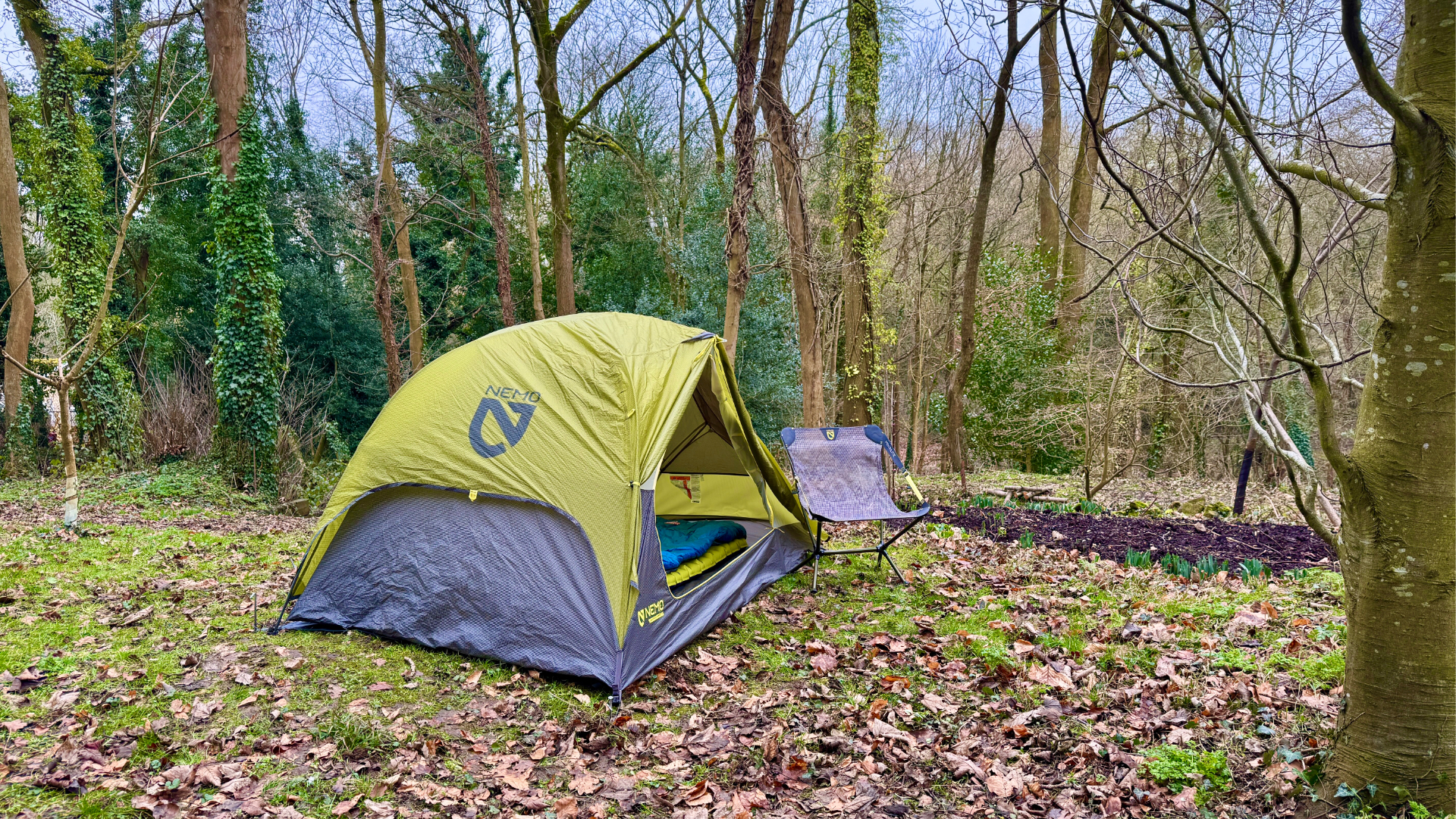
When tent manufacturers describe a backpacking tent’s size as being one, two or three persons, what they mean is the absolute maximum occupancy with all parties sleeping head to toe for a better night’s kip. It’s as if they measure the dimensions of the tent to fit exactly two or three (dead) people side by side on their backs with almost no margin for movement.
This is why I always say to go for a tent with almost twice the stated occupancy when backpacking and, for much better comfort when family camping, at least twice or even three times the size, cost and car-boot space allowing.
Hence, while the one-person version of the Nemo Dragonfly would certainly be perfectly acceptable for a well-‘ard, seasoned solo backpacker, I personally wouldn’t dream of squeezing into a coffin-sized module when another £60 buys a lot more space in the Dragonfly 2-person variant we have here. But each to their own.
Nemo is a premium US-based New Hampshire tent manufacturer specialising in ultralight backpacking tents and some of the best lightweight camping chairs and sleeping mats on the market. The company is renowned for the high quality of its products, both in terms of materials and construction. As a consequence, Nemo products aren’t cheap to buy. Nevertheless, in Nemo’s favour, it’s not hard to see where the money goes once you get your hands on one of its products and examine it more closely.
Take the two-person Nemo Dragonfly, for instance. At just 1.41 kilos in weight and a svelte 50 x 14 x 9cm when folded into its stuff sac, the Dragonfly is a brilliantly light, small-formed, three-season option for a solo adventurer – or two at a pinch – who wants more space to move about and store stuff when backpacking or bike camping. And believe me, the pack size will fit into a large-ish backpack and most panniers with ease.
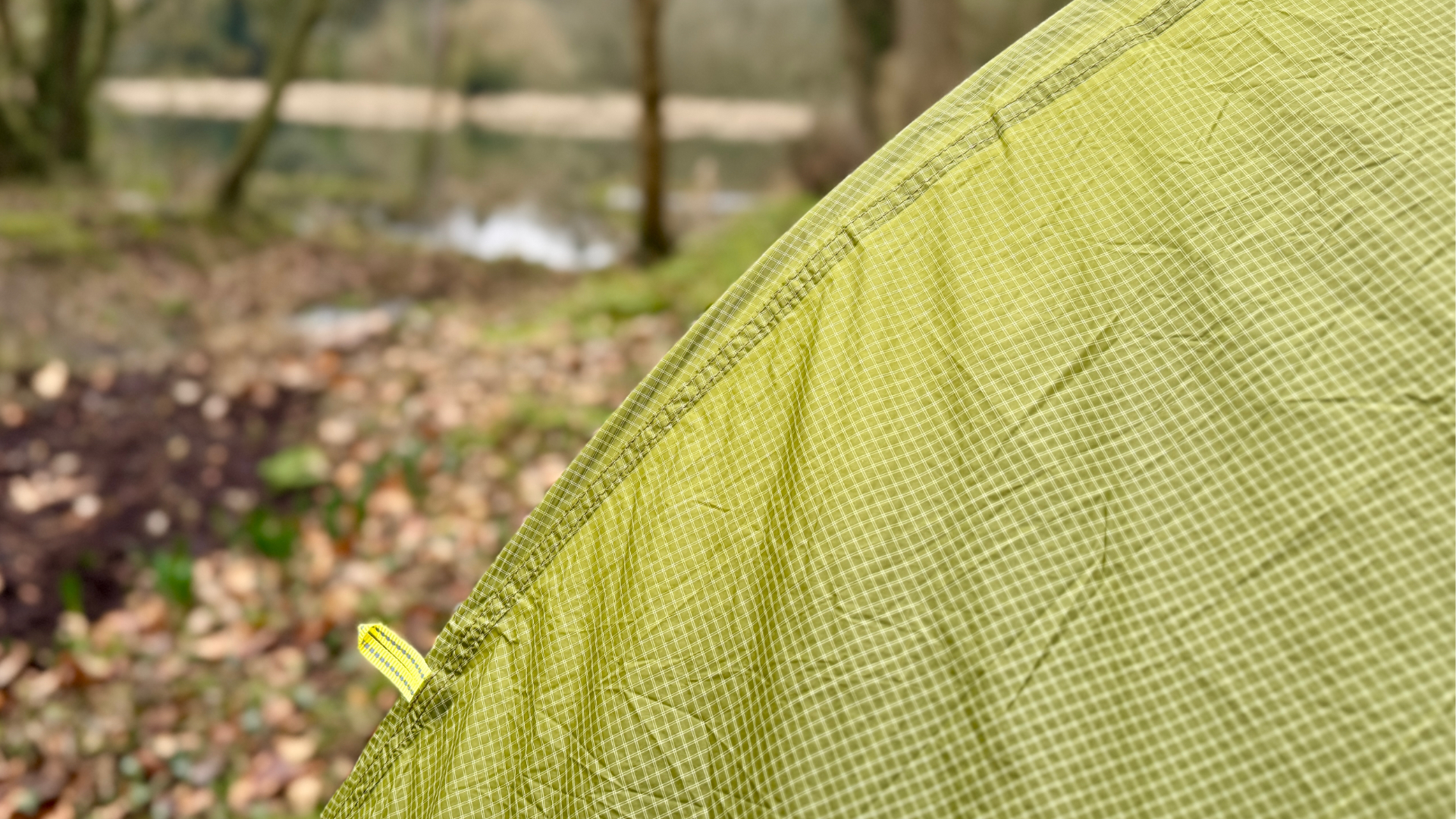
Let’s start with the all-important outer material, since that is what will keep you dry and comfortable. This model uses eco-friendly ‘bluesign approved’ OSMO, a proprietary mix of very thin nylon and polyester that boasts great water repellence (1,500mm) and no stretching when wet. According to Nemo, the OSMO skin ‘repels water 4x longer, and stretches 3x less when wet while boasting a 20% increase in strength compared to similar fabrics’. The floor section, meanwhile, sports a hydrostatic head of 2,000mm.
However, I would definitely invest in the Dragonfly-specific Footprint (£60, NEMO) if you think you will be pitching on rough ground. This groundsheet sports the same 2,000mm hydrostatic head so it will add extra protection against wet ground, stones and twigs while keeping the outer side of the tent’s thinner floor material mud free for neater packing.
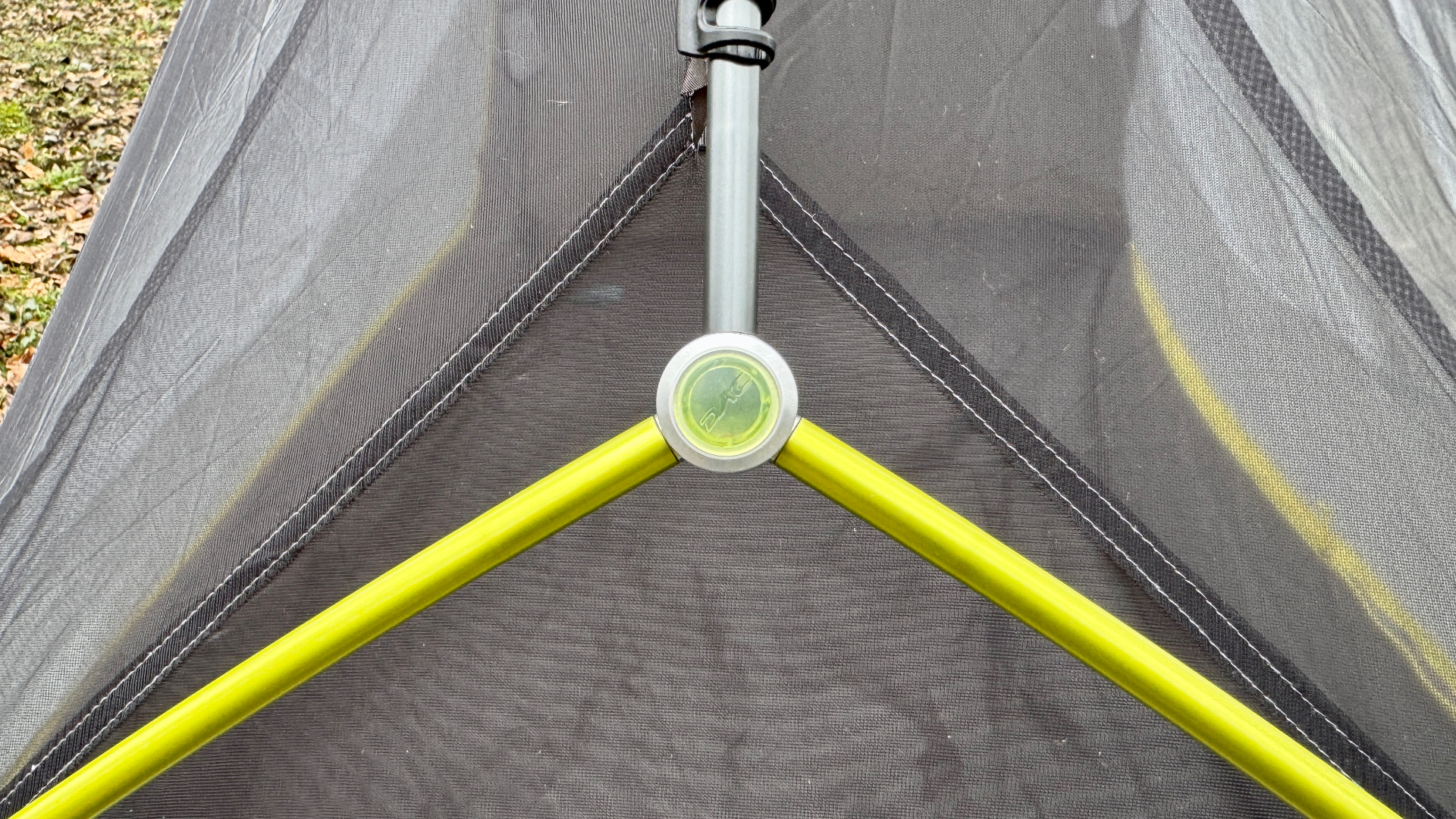
Fine details abound, like this integrated aluminium pole hub
This model adopts a geodesic-style criss-cross design comprising three colour-coded cross sections for roof and side support. The lightweight pre-bent poles – all pre-connected and made from DAC Featherlite NFL extruded 7001 aluminium alloy – join at two ceiling sections using a three-point aluminium hub and four colour-coded quick-release ‘Jake’s Foot’ pole clips on each corner of the floor. I loved the way everything so easily clipped together and how intuitive the whole assembly process was.
Regarding tie downs, there are six floor anchors – four on each corner and another two for each vestibule. There are also another five guy line points with nylon guy lines around the upper half of the tent.
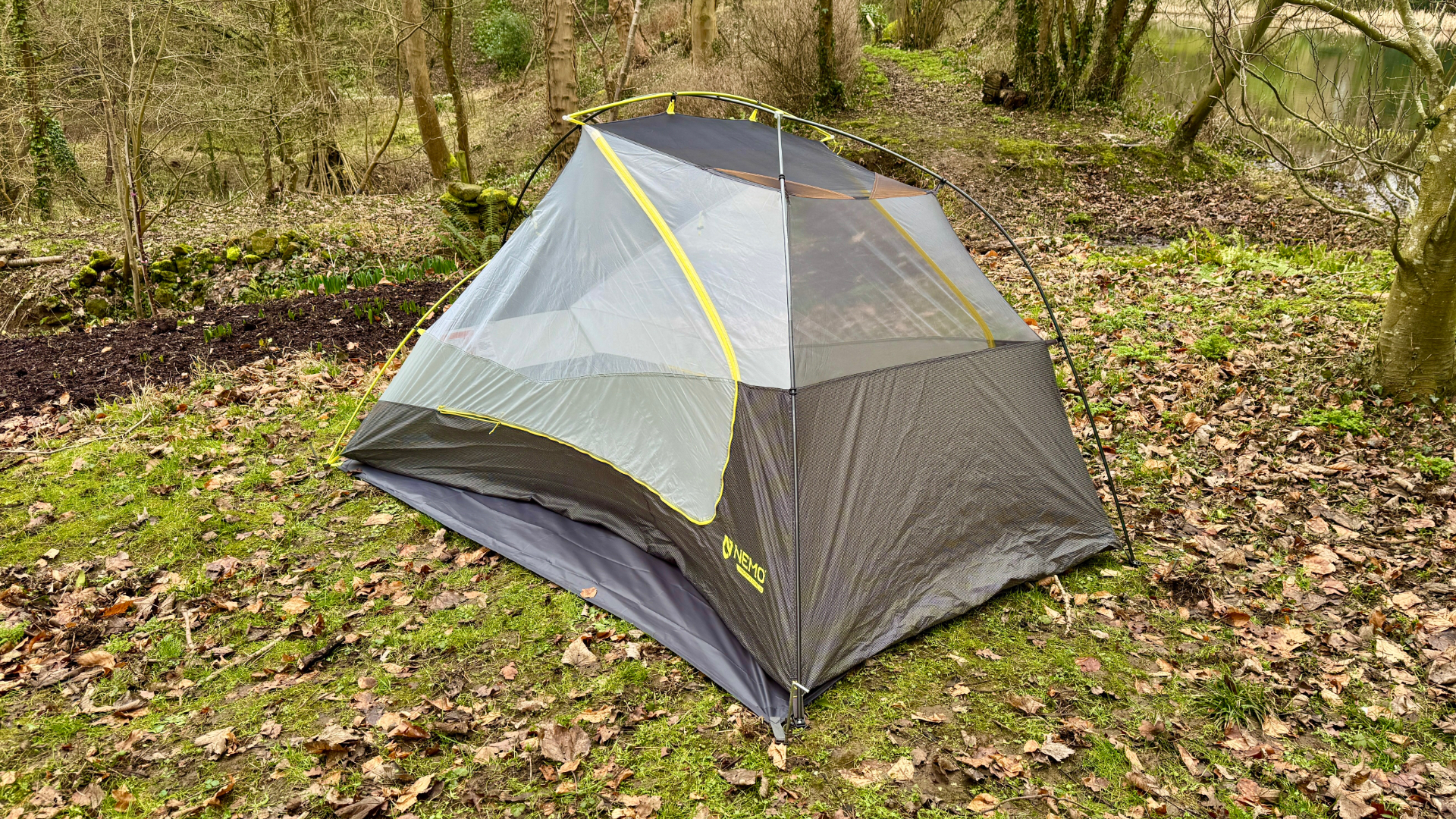
The inner tent is comprised of a lower swathe of Ripstop for privacy and increased warmth in windy weather and the entire upper half is no-see-‘em mesh for ventilation and protection against insects while allowing a full view of the night sky if pitching without the outer fly during hot weather.
This two-person variant comes with two vestibules – one on either side – so if being used by two people, you won’t have to crawl over each other to get in and out. The under-cover vestibule also provides space on either side for boots and small backpacks though there’s plenty of space inside if using the tent on your own. Both portals come with door tie-backs to make for easy entry and exit, and I was very impressed with the hidden strut vents that create a couple of inches of ventilation around the doors when they’re sealed.
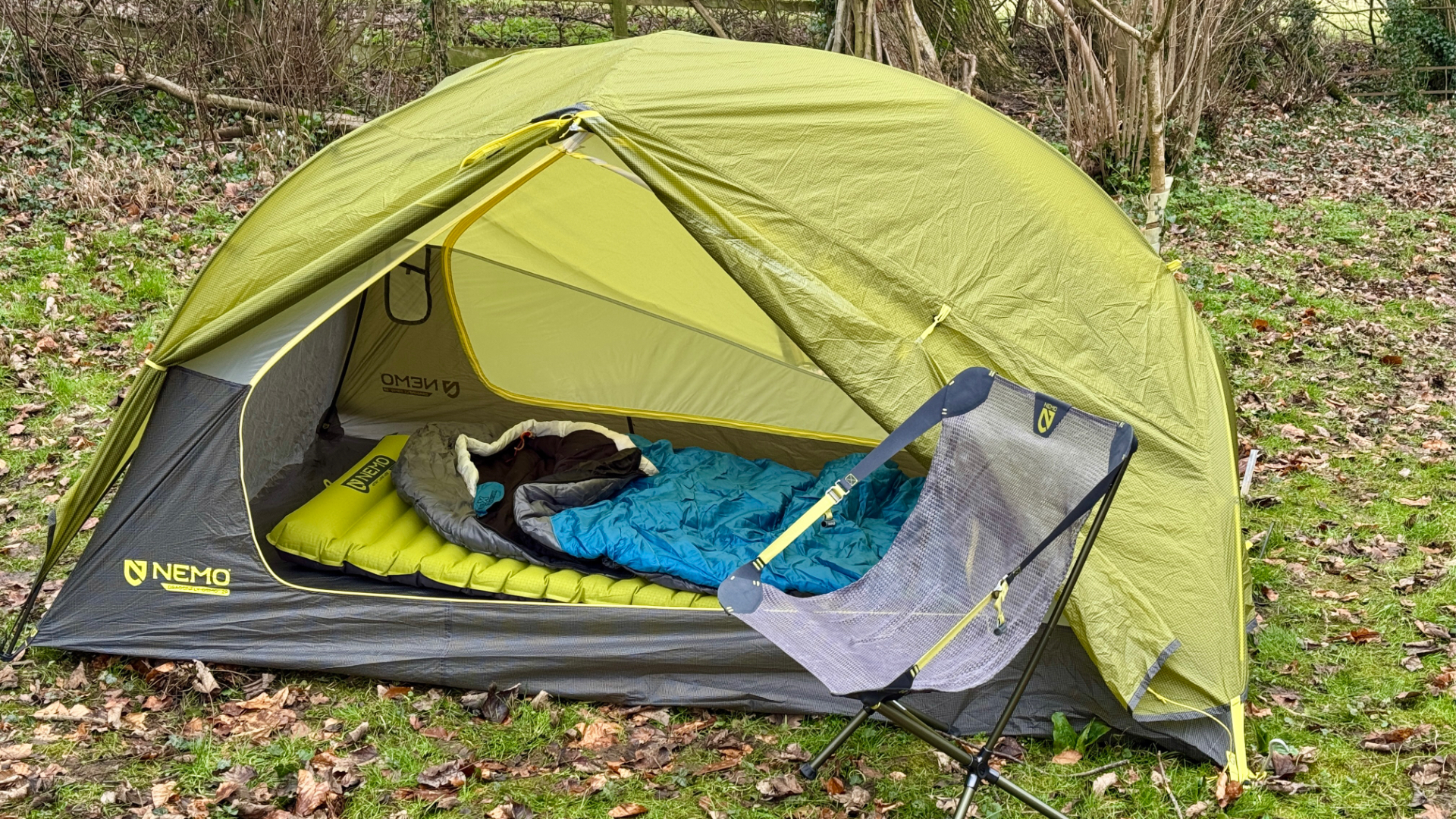
The interior floorspace measures 204cm in length and 110cm in width at the head end, tapering down to 102cm at the feet end. This is just about wide enough to accommodate two slim tapered sleeping pads. Crucially, the head side is high enough to use a lightweight camping cot like the Helinox Cot One Convertible without the back of the tent touching your head.
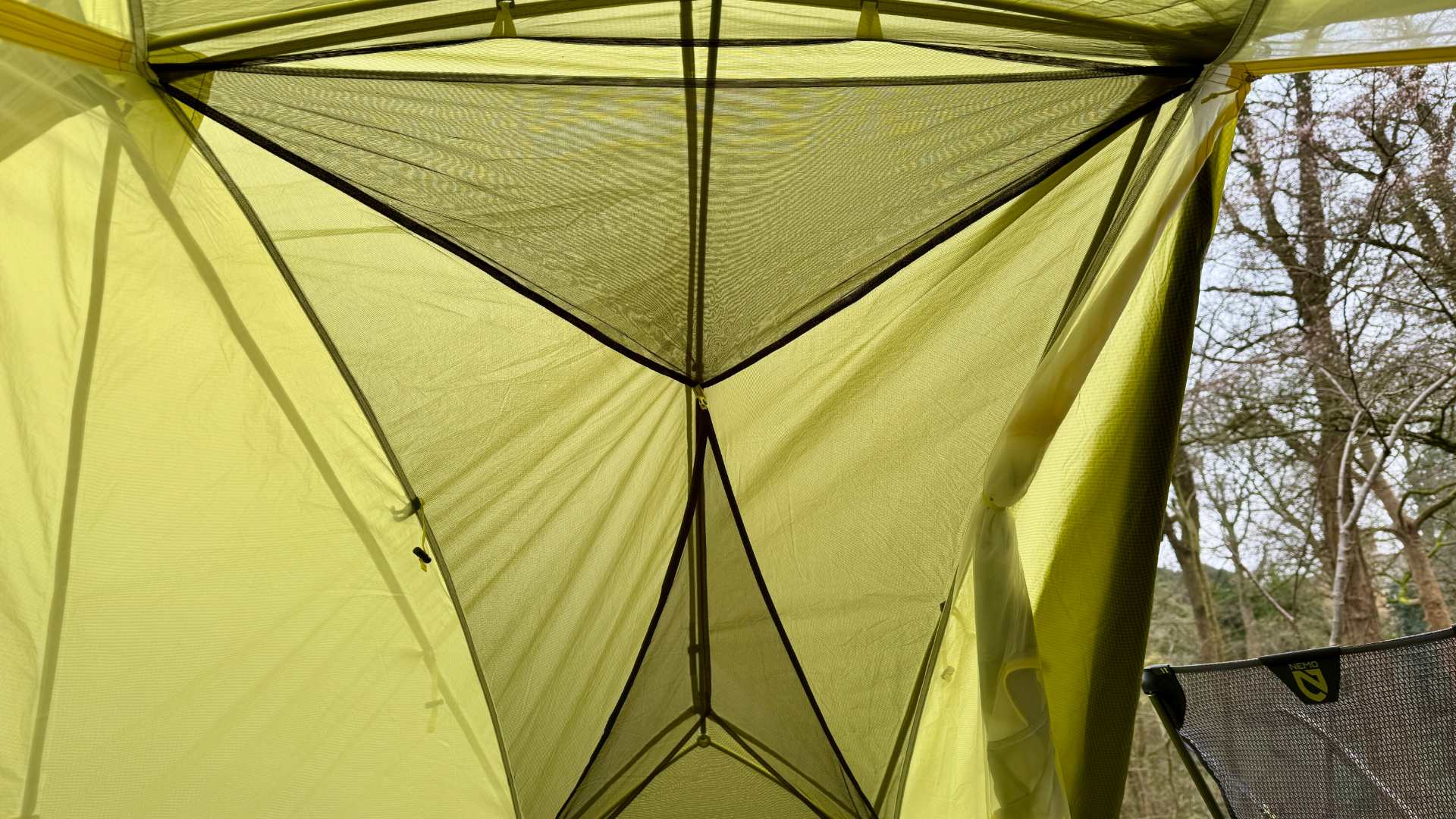
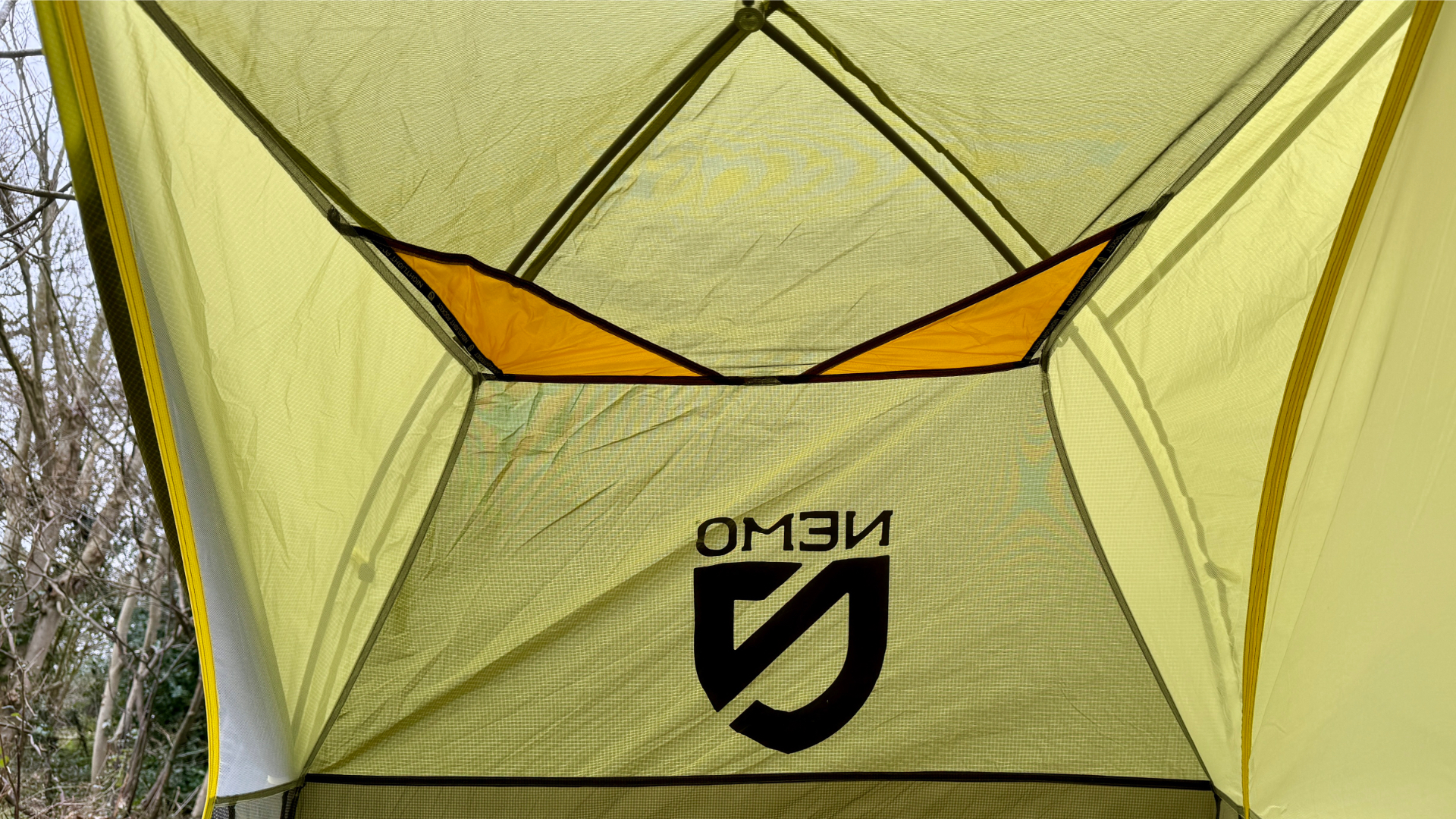
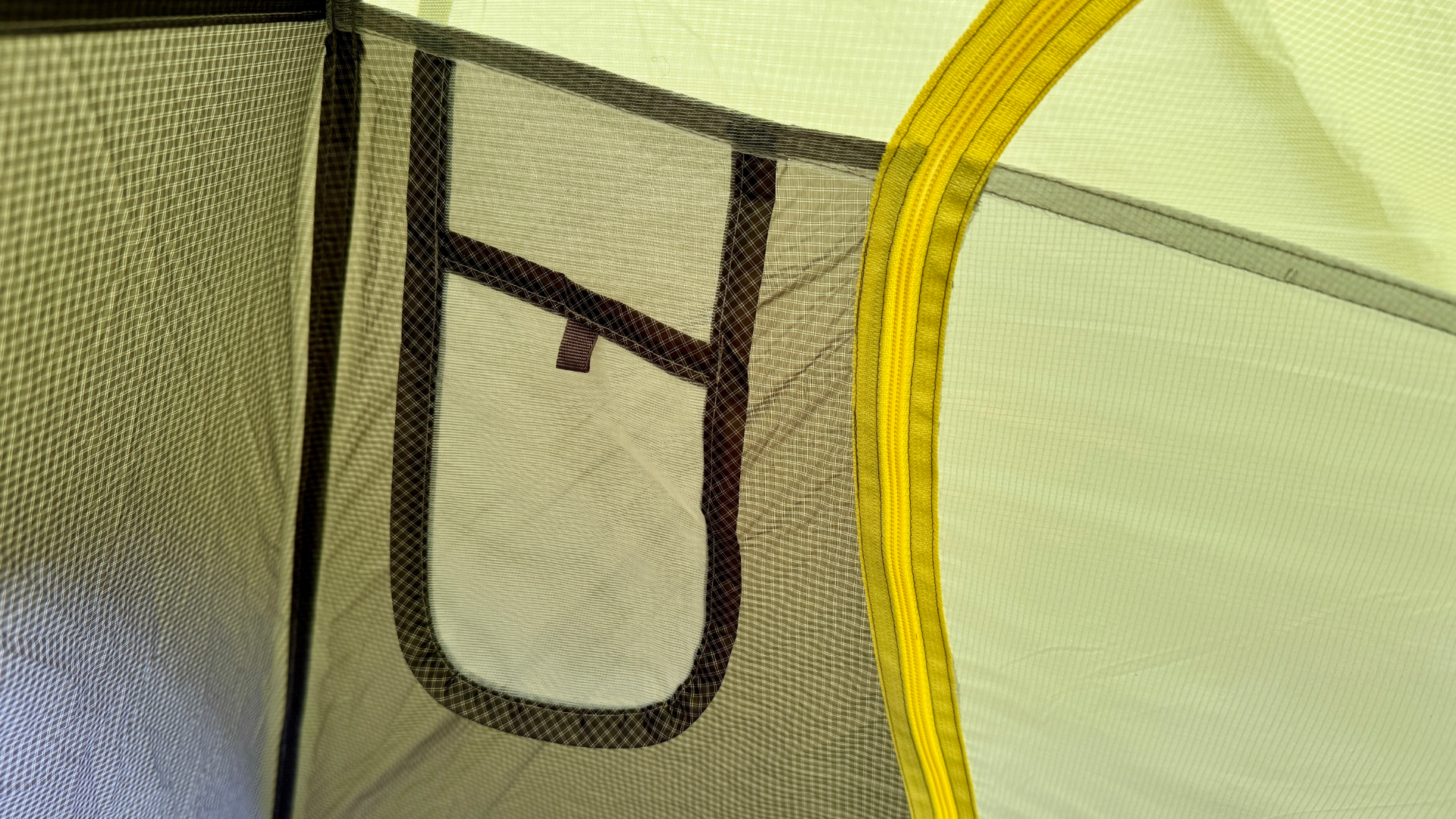

Inside you get two large triangular upper mesh shelves for storing maps and other essential items, plus two small pocket slips on either side of your head when sleeping. The interior also includes two mesh overhead nightlight pockets that help create a diffuse glow, especially if using a multi-coloured lamp like the excellent BioLite AlpenGlow Mini.
Ergonomics and comfort
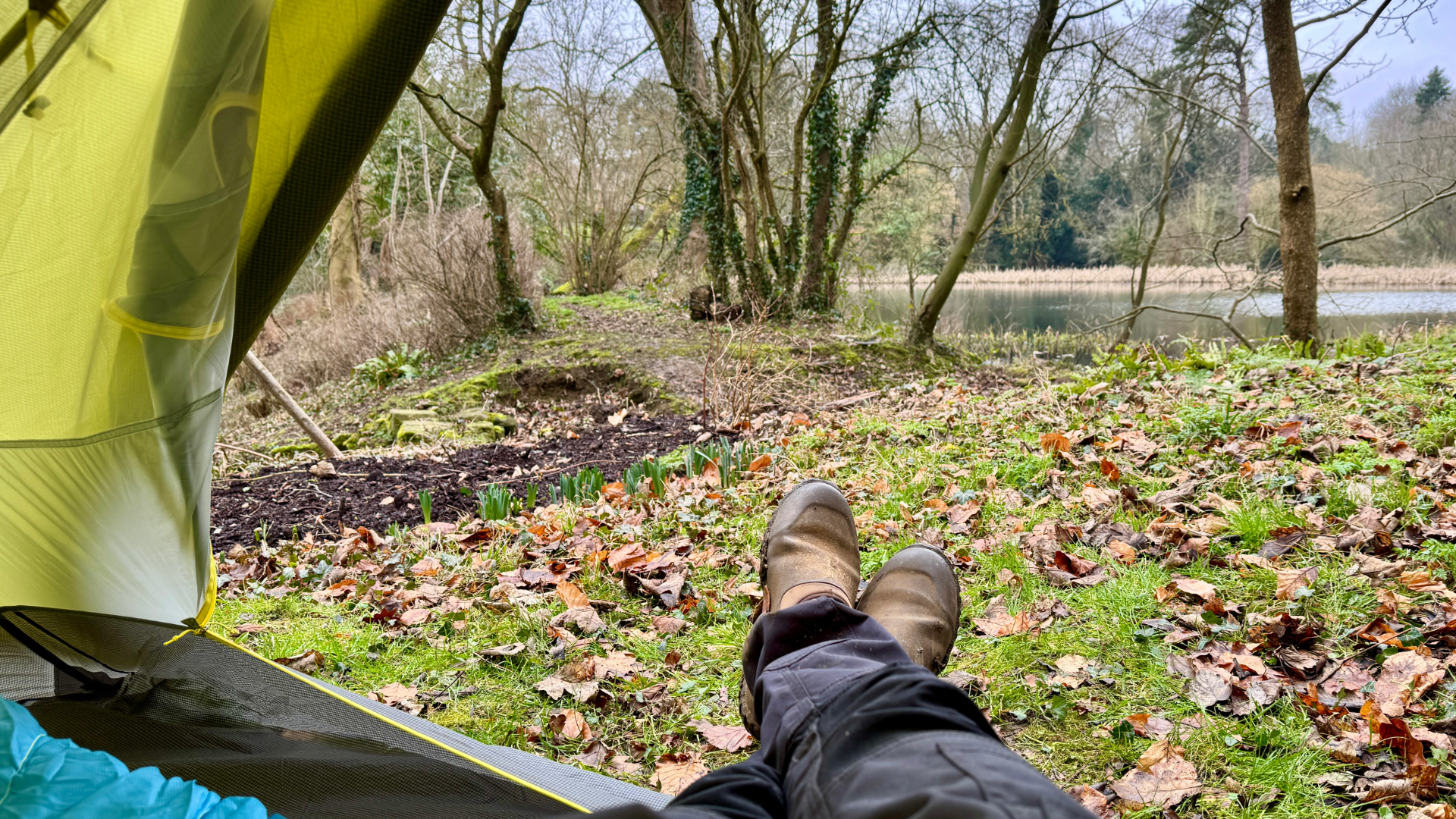
Since I pitched the Nemo Dragonfly during a stagnant period of cold, dull and windless weather, I wasn’t able to experience the tent's performance in wind or rain, but from what I’ve read and videos I’ve seen, this second OSMO-monikered incarnation of the Dragonfly range appears to hold up exceedingly well in stormy weather. And so it should given its premium status.
This two-person model provides great internal comfort – especially for one – with plenty of space to keep a backpack and other essentials dry and safe from inquisitive wildlife. I found it a very comfortable, well ventilated space to while away the time and I really enjoyed the view from inside through either of the extra wide portals. At 105cm, it has excellent headroom, too.
However, I’d have preferred to have seen a grippy toggle attached to the ends of the inner doorway’s zippers instead of just two pieces of tied nylon strings. The same goes for the vestibule zips since they’re not easy to grip at the best of times and less so when wearing gloves.
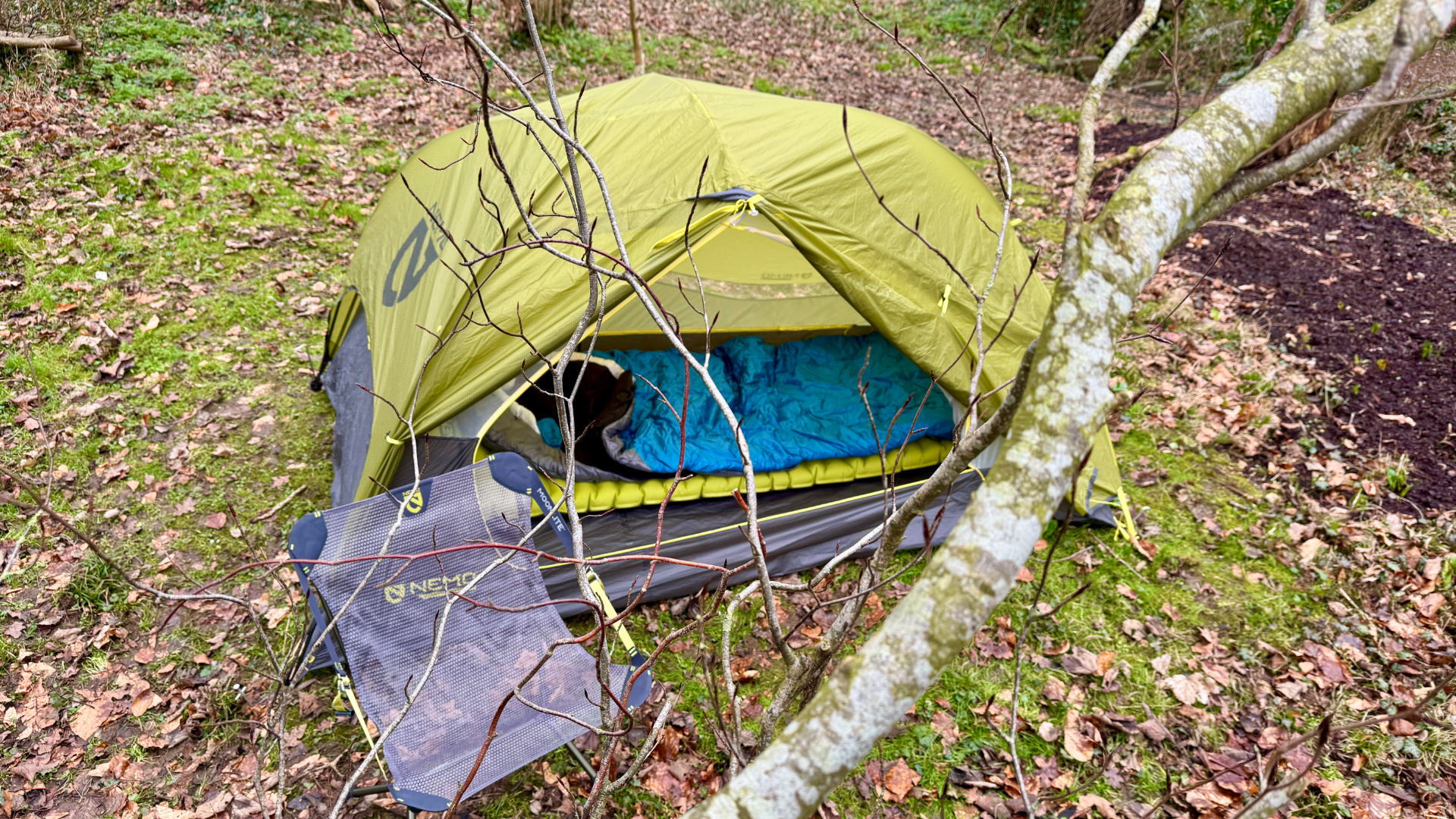
Having spent some time in a woodland, the things I appreciated most about the Dragonfly OSMO were the overall space – enough to accommodate a camping cot, backpack and other camping accoutrements – the twin vestibules, surfeit of internal pockets, and the very handy overhead mesh nightlight holders that helped give the tent’s attractive shade of avocado green a very pleasant nighttime glow.
Since this is a premium-priced option, the excellent build quality, fault-free stitching and expert choice of materials didn’t surprise me. After all, it’s the least you’d expect from a brand renowned for its high-end workmanship and relatively lofty price structure. Just as well it comes with a lifetime warranty.
I’d say that if looked after and used with the Dragonfly-specific outer groundsheet, this tent should give you many years of amazing outdoor adventures, whether it’s wilderness camping, world-wide backpacking, bike camping or even the odd car-camping folly.
Verdict

Nemo's Dragonfly OSMO 2 is a fantastic lightweight tent that pitches easily while offering surprising headroom. However, the real clincher is undoubtedly the tent’s ultra-light OSMO fabric with its high water resistance and reduced stretch properties. While admittedly pricey, the weight savings and overall build quality make the Dragonfly OSMO a top contender for serious backpackers seeking comfort and performance.
Sign up to the T3 newsletter for smarter living straight to your inbox
Get all the latest news, reviews, deals and buying guides on gorgeous tech, home and active products from the T3 experts
Derek (aka Delbert, Delvis, Delphinium, Delboy etc) specialises in home and outdoor wares, from coffee machines, white appliances and vacs to drones, garden gear and BBQs. He has been writing for more years than anyone can remember, starting at the legendary Time Out magazine – the original, London version – on a typewriter! He now writes for T3 between playing drums with his bandmates in Red Box (redboxmusic).
You must confirm your public display name before commenting
Please logout and then login again, you will then be prompted to enter your display name.
-
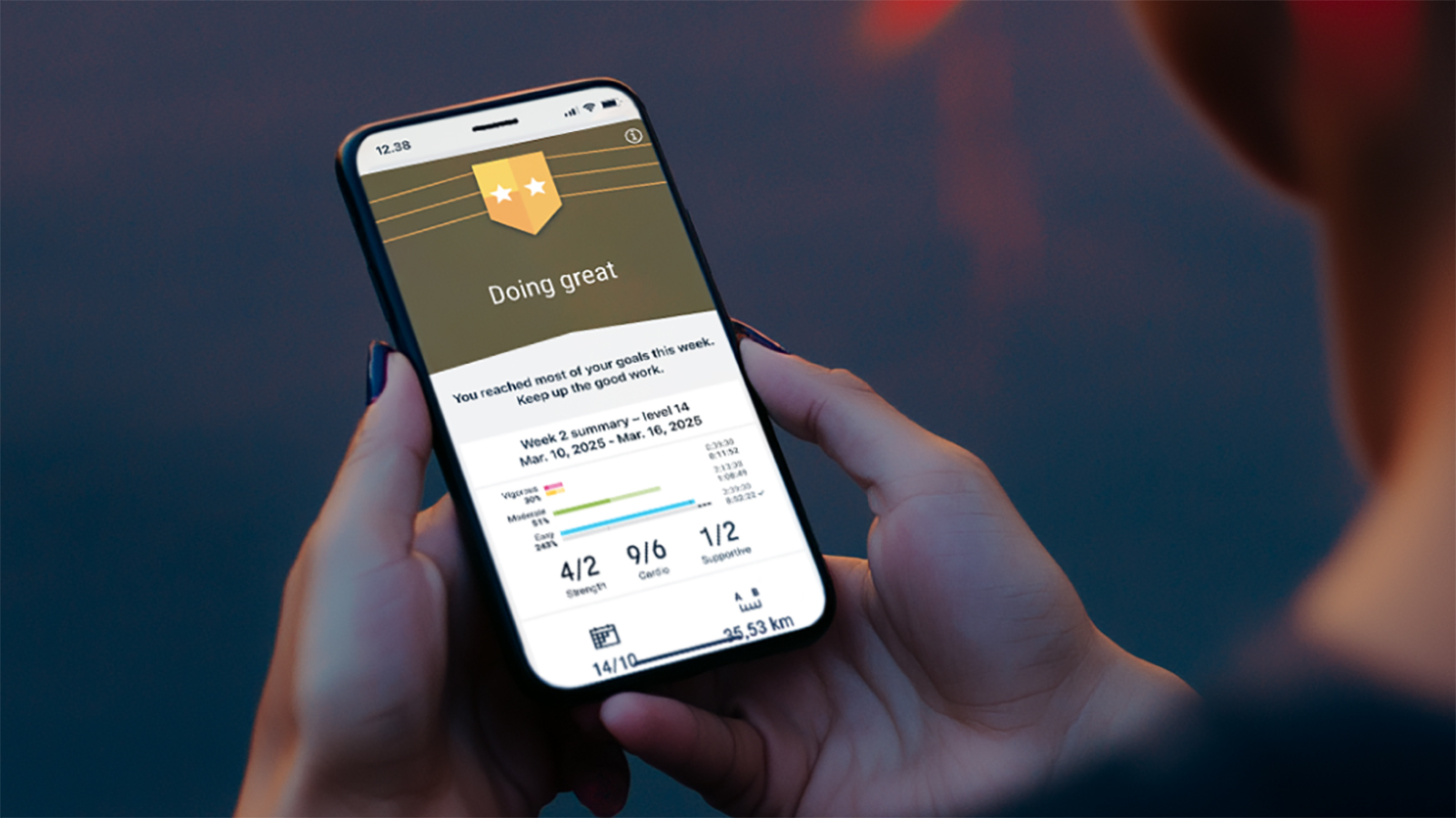 Polar’s new subscription feature lands in the shadow of Garmin’s Connect+ rollout
Polar’s new subscription feature lands in the shadow of Garmin’s Connect+ rolloutPR genius or timing disaster? Polar’s new Fitness Programme adds adaptive training to its ecosystem
By Matt Kollat Published
-
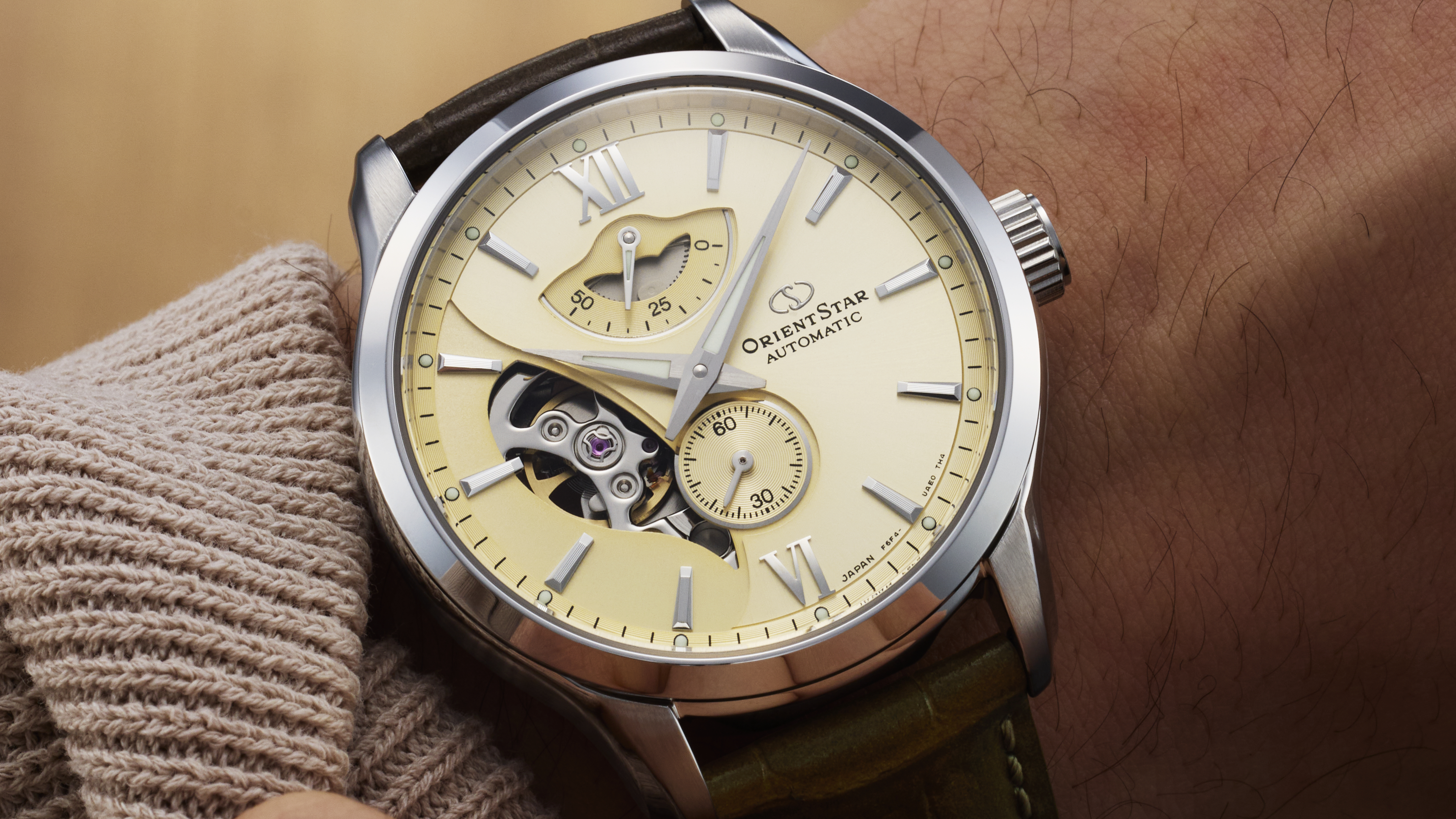 New Orient Star watches offer a glimpse of the magic within
New Orient Star watches offer a glimpse of the magic withinThere are two new skeleton pieces
By Sam Cross Published
-
 Netflix's most surprising 100%-rated sci-fi series returns with gorgeous trailer
Netflix's most surprising 100%-rated sci-fi series returns with gorgeous trailerLove Death + Robots is back for more
By Max Freeman-Mills Published